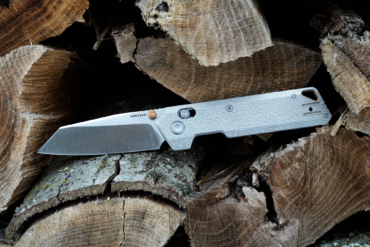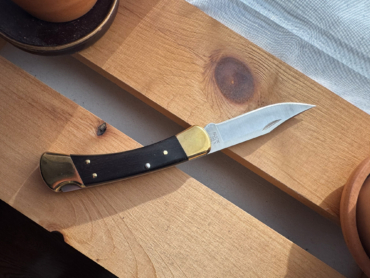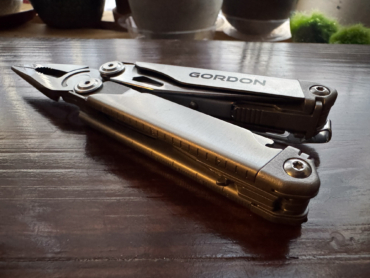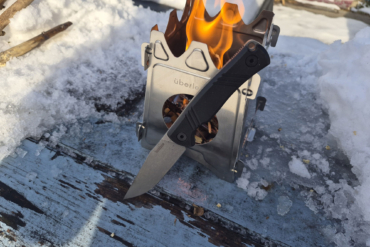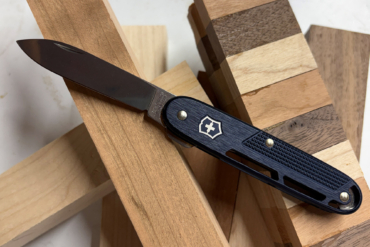Gerber Armbar Drive brings big utility to common home repair and backcountry travel scenarios on a pocket-size budget.
At under $40 and with three color options, Gerber takes a big risk putting the Armbar Drive on the marketplace. Why? It displaces more expensive options while replacing the need to carry common tools on foot, bike, in a pack, or in the cab (of anything).
The Portland-based toolmaker positions the Armbar as a way to “get your multitool out of the truck and into your pocket.” Solid marketing copy but, in our testing, it undersells where this model performs, both at home and in the field.
On the pocketknife side, a single, plain-edge 5CR15MoV stainless blade waits inside the truss-like frame. Listed at 2.5 inches, the extended-and-locked knife configuration gives full access to the blade’s entire length.
Here, “catalog spec” and “real-life” match one-to-one, as the Armbar behaves more like a dedicated folding knife. It also has enough carbon content to spark a ferro rod with moderate effort while remaining corrosion-resistant.
In short: Even without the other tools, the steady blade and agile driver of this pocket-size multitool make it worth carrying around the house or into the backcountry. While the metal used is far from legacy quality, the Gerber Armbar Drive is a solid choice for light- to moderate-duty repair, cutting, and snipping chores.
Solid Grip for Precise Tasks
With a solid grip below and my thumb on the blade’s spine, I could apply significant pressure without losing edge (or tip) control. This directed, accurate force shows up in cutting as well as carving.
In testing, I was able to trim half-inch-diameter wooden pegs for an under-construction mahogany Noah’s Ark playset quickly, accurately, and safely — despite a tenuous grip on the 2-inch-long dowels flowing out of the scroll saw.
When cutting cardboard packing materials, splicing plastic irrigation tubing, and digging a camera tripod anchor hole in clay were the tasks at hand, the Armbar Drive remained laterally stable even though the blade is positioned on the left side of the knife (normally a wobble-prone location on an under-$100 multitool).
Weak Link in Locking
Although I had no lack of confidence in the blade’s ability to remain steady and cut well, the locking mechanism is the Armbar’s weak spot. The glitch is not because the one-handed operation doesn’t yield a safe, locked blade, but due to the precise, small-scale release mechanism attached to it.
Stamped with “UNLOCK,” a lock icon, and a raised activation bead, the Armbar’s effective release zone ends up being only about a half-inch wide. Big thumbs, dirty fingers, cold hands, and wet digits may struggle to fully depress and activate it — with one hand or even two.
Also, left-handers are out of luck on easy opening, locking, and closing. The tool also lacks a suitable place to secure a mini-carabiner or nylon cord lanyard to prevent loss.
But the blade unlocking mechanism proves to be only the small-scale, fussy part of this bigger-behaving multitool. At 6.5 inches overall and 0.7 inches wide, there’s plenty of room to pack in a 2.5-inch extension bit driver (with two-sided bit standard). This accompanies a pry bar, a bottle opener, a hammer, scissors, and an awl.
Beyond the blade’s efficacy, the other Armbar functions (and affordability) justify stepping away from Gerber’s blade-only line — including the folding Covert ($140), fixed-blade Principle ($60), and Spine ($38) — when strict utility is the metric.
Multitool Test on Old Dishwasher
I put the Armbar through its paces on a 14-year-old GE dishwasher lobbying to stay put despite fatal water pump problems. The tool’s magnetic bit driver (non-locking) freed the obstructed bottom rail. Using the empty socket at a variety of unnatural angles (between 10 and 40 degrees) made this a much easier task.
I then loosened the hose clamps with the Phillips screwdriver at counter level and a modified knife grip. This required some extra vigilance, as the stealthy black bit wanted to hide from sight when separated from the driver socket. And while the Armbar Drive comes standard with a twin-sided bit, Gerber’s 10-Piece Tool Kit ($19) provides more options in stainless steel.
Next to the driver is the profoundly pointy awl. While some multitools play at providing point-specific power, this one is beveled on one side for sure slitting of heavy fabrics, hides, and even lighter metals. More everyday tasks could include pulling staples, tacks, and wire. Blade locking isn’t necessary to work safely in a wide range of conditions.
Scissors, Hammer, and Other Functions
Scissors slot in next, with one of the least-rickety mechanisms I’ve seen on a multitool of any size in some time. Because the Armbar’s scissors have a narrower cutting opening (versus a large, jaw-like gap between blades), the blades are far less prone to deflect when being squeezed together for a cut up to an inch in length.
The result from the stamped tool, finished to 1 mm, is more reliable, consistent cutting, albeit at a slightly slower speed. Fabric, threads, and, once again, lighter metals, yielded to the scissors. While questionable for heavy-duty or frequent use, lighter or occasional cutting seems well within the Armbar scissors’ capabilities.
Pry bar, bottle opener, and hammer sit opposite of the other tools, representing a trio of functions more connected to force than precision. The ridged hammer represents blunt-force impact that needs to be delivered in a small area (between a quarter-inch and a half-inch) such that many tasks beyond (re)bending a camera bracket, small clevis pin, or a belligerent gear case latch are simply too big to tackle.
Here, there’s little margin for error, as the hand applying the hammer blow has no protection from an errant strike. The pry bar tool handles car varnish lids with aplomb, and the bottle opener works as advertised.
Gerber Armbar Drive: Should You Buy?
Short of bayoneting wet wood or dry limbs more than one inch in diameter, the Armbar Drive goes into the backcountry ready for basic repair tasks. While pliers often end up being of high value, Gerber wisely avoided adding weight and bulk with a tool that needs to be somewhat beefy to function.
Instead, the company centered its efforts on a lighter EDC-category tool with more practical ideas for any pocket — from jeans to board shorts to trail pants. And finally, don’t forget to keep it in checked luggage, as this one’s too good to see tossed into the plastic-box vortex at airport security.







